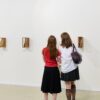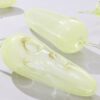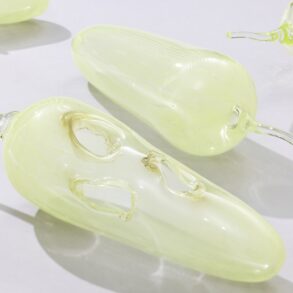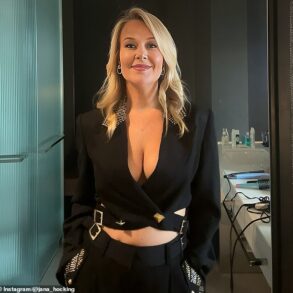
The Remai Modern gallery in Saskatoon is stretching itself to display Sun Ascending. The 1985 tapestry by Finnish-Canadian artist Kaija Sanelma Harris is almost four metres high and a whopping 20 metres wide, designed to be hung in a massive bank lobby. It was woven in 24 panels and the Remai has had to build false walls in two corners of a big gallery so that the tapestry, an abstracted Canadian landscape, can flow around the room.
The piece was designed for the modernist towers of the TD Centre in Toronto but by 1990 the bank and developer Cadillac Fairview wanted to refresh the art on display. Cadillac Fairview donated the tapestry to Regina’s MacKenzie Art Gallery, which has only displayed it in its entirety once, in 2023-24. The Remai has borrowed Sun Ascending for a current retrospective devoted to Harris, who died in 2022. She was once a major Canadian artist and leader in the Prairie craft community, but her innovative weaving had been forgotten as textile wall hangings, so popular in the 1960s and 1970s, fell out of favour.
The installation of Sun Ascending marks an important revival: In the museum world, textiles are hot, pursued by curators looking to rediscover the artists, mainly women, who made them.
“During a period when everybody was into big monumental painting and people weren’t really thinking about gender equity in the arts, these works got pushed aside,” said Remai curator Michelle Jacques. “Now that there’s a realization we have a responsibility to all our art histories, we are rediscovering these things with a more open eye.”
Finnish Canadian artist Kaija Sanelma Harris’s Sun Ascending (1985) on display at the Remai Modern gallery in Saskatoon, is made of tapestry, wool and linen, consists of 24 panels and is almost four metres high and 20 metres wide.Carey Shaw/Remai Modern
Art museums are seeking to rebalance collections dominated by men’s work, providing the initial impulse in this renaissance. Textiles, historically and currently, are made primarily by women – and were often relegated to the realm of craft rather than fine art because of that.
Harris designed large collectable tapestries whose role was aesthetic, but she also made money weaving blankets, shawls and placemats. Women’s functional work in textiles goes back centuries, yet the names of the weavers, seamstresses and quilters are often lost in time. The Royal Ontario Museum is currently showing some quilts made by Canadian settlers in the 19th century.
Sometimes the makers are known – because their descendants donated their handiwork to the ROM – but sometimes curators can only guess as to who made a quilt. One piece in the collection, made in Ontario around 1880, features 8,000 separate triangles of fabric, leading the ROM to speculate that many hands produced its intricate grid of shifting patterns.
Although quilts, often made by a bride, were an opportunity to show off skills, they were assembled from scraps of discarded clothing and can sometimes be dated by the fabrics that appear in them. Combining frugality with beauty, they reflect a reuse-recycle philosophy with contemporary appeal.
A household may have hung a quilt over the back of a couch to impress guests but the pieces were primarily practical, made to keep the bed warm. It was in the mid-20th century that textiles found their non-functional role, in the canon of modernist art.
An exhibition about to open at the National Gallery of Canada in Ottawa will cover that ground, pairing paintings, sculpture and photography with weaving, basketry and fashion. Curator Lynne Cooke, who organized the show for the National Gallery of Art in Washington, argues that woven textiles were as important a medium as painting or sculpture in the years after the Second World War
For example, she compares the fibre works of the American Lenore Tawney with the grid paintings by the Canadian-American abstractionist Agnes Martin. She points out that the American weaver Sheila Hicks, belatedly acclaimed as a major contemporary artist, studied with the great modernist teacher Josef Albers at Yale, alongside the German-American sculptor Eva Hesse: One woman chose fibre as her medium; the other plastic and fibreglass.
“The history of modernism cannot be written without reference to the history of textiles,” Cooke said.
These artists valued the materiality of textiles and could use them to create abstract forms just as effectively as any painter or sculptor did with his medium. By the 1960s and 1970s, however, second-wave feminists were using textiles for different reasons as they sought to revive or elevate traditional domestic crafts. The Canadian artist Joyce Wieland was a leader in this movement as she introduced quilting to her work in the 1960s.
“She was embracing women’s work that had been overlooked,” said Anne Grace, curator at the Montreal Museum of Fine Arts where a Wieland retrospective opens in February. Grace points to aspects of quilting that appealed to Wieland because they circumvented the art market and the cult of the lone male genius: Historically, quilting didn’t involve any payment or profit, and was often done communally. Wieland, who had begun quilting to help her sister, was scrupulous about acknowledging her own helpers when she showed the work as art.
The distinction between art and craft is a Western one; the Woven Histories show includes some Japanese basketry – itself a form of weaving – from a society that revers its best artisans as significant cultural figures. So, the revival of interest is also driven by a desire to expand the canon beyond the West.
The Art Gallery of Ontario is currently showing large-scale wall hangings by the Filipina artist Pacita Abad, who died in 2004. A world traveller, she had lived in the U.S. for a time, but was previously identified only as an Asian artist: The show is the first major retrospective in North America and marks a (posthumous) Canadian debut.
Abad had developed her own version of trapunto, a technique of embroidering on a painted surface, by hand-stitching and stuffing her canvases. The colourful hangings reach as high as double-height ceilings and every inch is covered. The imagery includes abstract patterns, portraits of immigrant workers in the U.S., exotic underwater scenes and even a risky satire of Philippines dictator Ferdinand Marcos. AGO curator Renée van der Avoird associates Abad’s maximalist style with the Global South.
“The work is incredibly powerful in terms of scale and composition. It is resonating strongly now because of the feminist and anti-colonial aspects. She was always political,” she said. “It’s exciting to see a woman of colour taking up space as an act of defiance.”
Once this wave of focused exhibitions has passed, museums may be more likely to display textiles alongside collections of painting and sculpture, as Woven Histories’ example suggests they should. Paradoxically, it’s the Textile Museum of Canada in Toronto that has made a big move in that direction: Its current exhibition, Beyond the Vanishing Maya, features Mayan art in multiple media. To demonstrate how contemporary Mayan artists are influenced by traditional forms, guest curator Diego Ventura Puac-Coyoy has paired his family’s collection of local painting dating from the 1980s to the present, with the museum’s textiles dating from the mid-20th century on, as well as some loans, including ancient Mayan ceramics from the Gardiner Museum.
“The priority for the museum right now is to work with communities that a have a direct connection with our collection: We have over 500 pieces of Guatemalan textiles,” chief curator Armando Perla said, explaining that Puac-Coyoy’s Indigenous community in Chichicastenango, about 150 kilometres northwest of Guatemala City, wanted the recent art to be seen.
The show includes lots of work by men as well as women – in Mayan culture, it was only men who used the foot looms and, once painting was introduced by Spanish colonizers, that was forbidden to women – and some work by queer artists. Juan Jose Guillen creates an elaborate altar for a local saint that includes crochet work by his mother, positioning the tradition of covering crosses with cruciform-shaped robes as a form of drag.
Still, textiles and the fibre arts remain strongly associated with women. When Workman Arts, the Toronto multidisciplinary group dedicated to mental-health issues, offered a weaving course to members working in other media, the applicants were all women. They found their workshops meditative and community-building, said curator Fatma Hendawy: In contrast to the abstract work of the modernist weavers, she believes there is a strong link between textile work and narrative. The sewing circle or the quilting bee was where women exchanged stories and gossip. Today, Hendawy believes that the storytelling thread is woven tightly into any textile we admire. “A century ago we saw a Persian or Turkish rug, woven perfectly, and we were just amazed by a perfect product. Now it’s not just an aesthetic object; we are aware of the process behind it. Now we want the stories.”
Textile exhibitions in Canada
On now
Kaija Sanelma Harris: Warp & Weft, a retrospective devoted to the Finnish-Canadian weaver, continues at Remai Modern in Saskatoon to March 9. The exhibition is a collaboration with the Saskatchewan Craft Council with one part showing in the council’s main-floor gallery until Feb. 8.
Quilts: Made in Canada, an exhibition of both historic and contemporary quilts, is on show at the Royal Ontario Museum in Toronto to Nov. 17, with plans for a national tour to follow.
Pacita Abad, the first major North American retrospective of the Filipina artist, continues at the Art Gallery of Ontario in Toronto to Jan. 19.
Beyond the Vanishing Maya: Voices of a Land in Resistance, a multimedia show of historic and contemporary Mayan art, continues at Textile Museum of Canada in Toronto to March 28.
Opening soon
The Looms We Resemble, an exhibition of work by contemporary Toronto artists incorporating weaving into their usual media, runs Nov. 3 to Dec. 9 as part of the Rendezvous with Madness, a mental-health festival at Workman Arts. In the Youngplace Hallway Galleries at 180 Shaw St., Toronto.
Woven Histories: Textiles and Modern Abstraction, investigating the connection between weaving and other media, opens at the National Gallery of Canada in Ottawa Nov. 8 and continues to March 2.
Joyce Wieland: Heart On, a retrospective of work by the 1960s-1980s Canadian multimedia artist renowned for her quilts, shows at the Montreal Museum of Fine Arts from Feb. 8 to May 4, before opening at the Art Gallery of Ontario in Toronto June 21.
This post was originally published on this site be sure to check out more of their content








